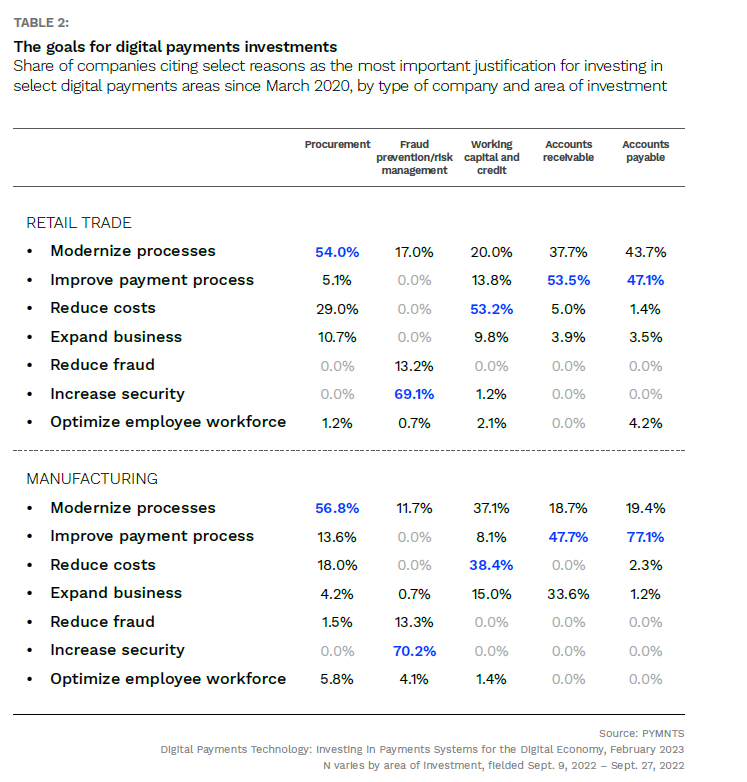Manufacturing CFOs Reset Innovation Investments to Maximize Long-Term Efficiencies

COVID-19 sent nearly everyone doing business within the eCommerce sphere scrambling to invest in tech innovations, mostly to get through lockdowns and the resulting economic fallout. The most recent PYMNTS/Corcentric collaboration, “Digital Payments Technology,” found that only 29% of surveyed companies had invested in new AP systems during the pandemic’s beginning. That sentiment was part of the general zeitgeist of short-term solutions, as 21% of all companies made investments and then focused on continuing operations.
However, by last year, drivers in tech investments for both manufacturing and retail had shifted to economic concerns and long-term sustainability in the post-pandemic economy. Because of these evolving goals, investing in tools like accounts payable (AP) or accounts receivable (AR) automation took a backseat compared to then-more important immediate investments, such as those impacting working capital and credit.
Sentiment has clearly changed since, as 81% of companies are investing or planning to invest in AP to improve their business processes. Modernization is becoming increasingly important across all types of payment investments for both retailers and manufacturers.
However, data shows that manufacturers overwhelmingly cite a singular reason for investing in AP innovations. We found that 77% of manufacturing CFOs are doing so to improve payment processes, leading all other justifications. For comparison, the next most popular reason for this investment is to modernize operations, and only 19% considered that motivation to be the most important.

This drive to continually improve payment processes has led manufacturers to continue investing in improving their current systems, including key financial innovations such as modernizing and reducing costs for AR and procurement. This includes, as further PYMNTS research found, 40% of manufacturers who had not already done so; they are also focusing on enterprise resource planning (ERP) investments for their AP systems. This automated “all-in-one” process is expected to streamline AP systems even more.
However, other tools are available for manufacturers who aren’t ready to invest in ERP or other more advanced capabilities. For example, in December, American Express announced the launch of its digital payments ecosystem for network participants. The company’s Business Link allows third-party issuers and acquirers to provide their business customers with more efficient domestic and cross-border payments. Specific to manufacturers, Business Link is meant to deliver a more convenient method of managing payments, gathering purchase and sales insights, as well as dynamic report production. The platform also permits various payment methods, including multiple cards, ACH and checks.
Perhaps more focused on serving small businesses, AvidXchange in December released an invoice-to-pay API integration with Intuit QuickBooks Online, allowing the latter’s users access to AvidXchange’s automated, cloud-based AP solution. The tool enables automatic syncing of accounting codes, vendor information, invoices and payments, helping users save personnel hours spent manually handling these AP tasks.
More recently, last month Order in Seconds released an eCommerce app designed for wholesalers, distributors and manufacturers. The app enables business customers to place orders by opening the app, selecting products and submitting orders through a digital product catalog, whether online or offline. The app also allows manufacturers and other vendors to add custom pricing and trade promotions for each customer and track the products and specials bringing in the most revenue.
Manufacturers are poised to continue leading sectors with their commitment to AP improvements. The innovations behind eCommerce investment may have changed since the pandemic’s start, shifting from short-term to long-term solutions. However, what hasn’t changed is the drive to streamline and improve systems to scale for realistic growth.
